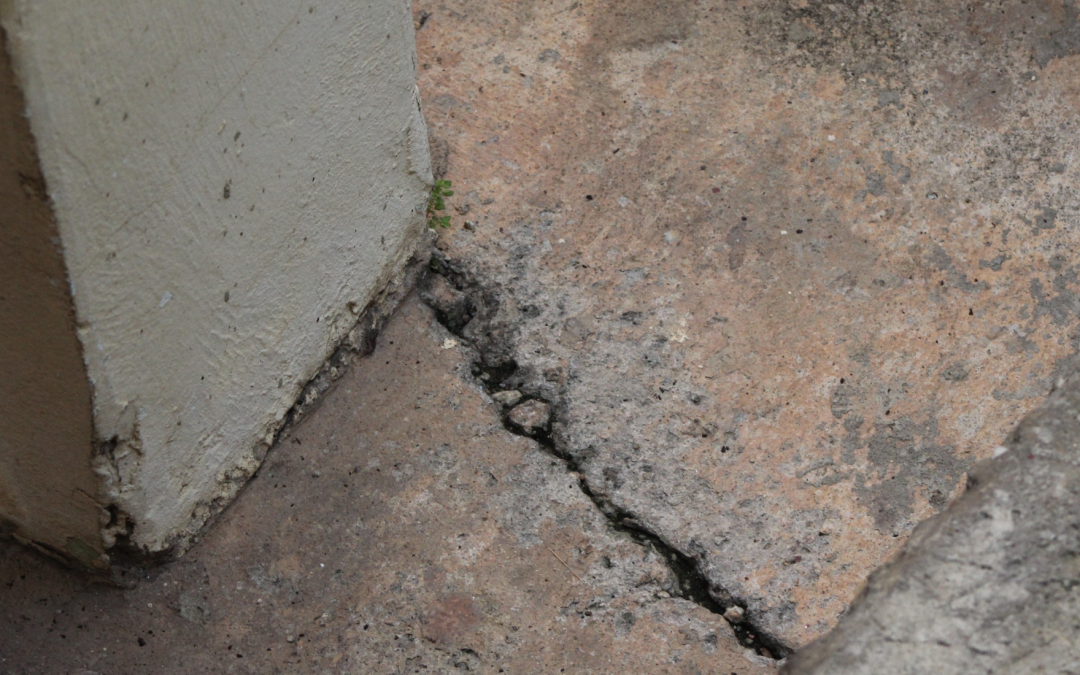Non-structural cracks are generally caused by stresses that are induced internally. A simple example would be a weld that cracks without any applied stresses from loads because of “leftover” or residual stresses due to uneven heating of the weld and the members it joins.
Kinds of Non-Structural Cracks
Shrinkage cracking
These occur invariably as concrete cures, but more noticeably if it cures rapidly. Concrete is made with a large percentage of water. As the water is used up chemically by the curing process, and by evaporation, it leaves behind voids (empty space between the solid particles) which allow those particles to move closer together. The drying and shrinking process happens faster at the surface than underneath, so the result is cracking, which is more severe and noticeable at the surface of curing concrete.
Although they are barely visible at the surface, they do also extend under the surface.
Shrinkage cracks are inevitable and do not seriously affect the strength of properly formed and reinforced concrete.
Large expanses of concrete without proper expansion joints and control joints can form larger cracks that result from the net shrinkage of large expanses. These must be planned for and controlled by, e.g., silicone contraction joints between sections of a concrete freeway pavement.
The following will control, but not prevent shrinkage cracking:
1. “Control joints” are cuts or joints in the forms or troweling joints that “force” the curing concrete to form larger cracks at pre-arranged places.
2. Misting water over the curing concrete will prevent excessive drying near the surface.
3. Pouring the concrete in the early AM or late PM hours will prevent excessive heat evaporation at the surface.
4. Covering the surface with plastic will slow the evaporation rate.
5. Using as low a water ratio possible in the mix will limit the size of the voids in the cured concrete, minimizing shrinkage.
Crazing and Crusting:
Crazing gives an “Alligator surface” of fine cracks which are only surface-deep on a poured and flat finished surface, caused by over-floating the concrete, creating a thick slurry layer with Portland and water only, and fast surface drying. The cracks are less than 1/16” wide, and generally do not affect the strength
If the top surface of the concrete which is to be stamped with the imprint of stone or brick surface texture cures and dries faster than the underlying slab, the edges of the raised stone or brick figures can have cracks form. This cracking on the edges of the raised imprints is called “crusting.”
Neither crusting nor crazing is caused by structural loads, nor should they affect structural strength under normal circumstances.
Structural Cracks
Caused by overloading, building errors, or design flaws, and may cause failure or other serious structural problems.
Kinds of Structural Cracks:
1) Settlement cracks are caused by soil voids or uncompacted soil which allows footings and foundations to settle under the weight of the building, or similar results caused by the action of erosion removing soil under footings and foundations. Generally, some parts of the foundation settle more than others, causing cracking of walls and foundations, as well as sloping of floors and potential failures of roofs, joists, girders, and columns.
2) Expansion cracks are caused by the expansion of a long or wide expanse of concrete without it having any “margin” to move into. Without any relief of expansion stresses, a long concrete road or sidewalk can crack and “buckle”, popping up like an uplifted mountain range between two continental plates. The normal way to prevent this expansion buckling is to install expansion material at regular intervals (silicone caulk, tar-soaked felt, or even treated lumber) which can absorb the movement. On bridges, this can be seen where metal sliding plates cover a narrow gap between two sections of concrete slab.
3) Heaving cracks are caused by uplift forces underneath generally a concrete floor slab or footing. Although this can occur because of tree roots, the classic case of heave is from expanding clays. In dry climates, the clay soils are generally very desiccated and shrunken at the surface, but when a “slab on grade” floor and foundation is placed over such soils, the soil moisture no longer evaporates at the surface, so it absorbs and holds more water, and thus expands, pushing up the slab and causing cracks and floor deflections.
4) Overloading cracks occur because the strength of concrete is misused in its installed situation. This can happen because corners of concrete slabs are not fully supported, then loaded by, e.g., a heavy truck driving over the corner. Precast beams and panels can also be lifted into place without using designed lift points, causing bending or shear stresses beyond the material’s capacity. If concrete is loaded to capacity before it is fully cured to strength, it can also crack and pull out reinforcement. Poor design can also fail to predict actual loads or actual strength in situ, causing cracking and potential failure…
5) Reinforcement corrosion is likely one of the causes of the recent fatal collapse of a portion of a condominium tower in Florida. Reinforcement bars placed too close to the edge of (porous) concrete beams or columns become exposed to seawater or road salt and rust. Since rust has 6 times the volume of the same molar amount of steel, rusting reinforcement can burst the concrete around it and cause structural weakness or failure.
Areté provides structural engineering design for homes and commercial buildings, as well as structural inspections and recommendations for bridges and other structures.
Do you have questions about concrete cracking or concrete design? Areté Engineering does structural inspections of homes and commercial buildings, plans for wall removals, decks, and other renovations, and structural designs for new homes and buildings.

